- News
- Reviews
- Bikes
- Components
- Bar tape & grips
- Bottom brackets
- Brake & gear cables
- Brake & STI levers
- Brake pads & spares
- Brakes
- Cassettes & freewheels
- Chains
- Chainsets & chainrings
- Derailleurs - front
- Derailleurs - rear
- Forks
- Gear levers & shifters
- Groupsets
- Handlebars & extensions
- Headsets
- Hubs
- Inner tubes
- Pedals
- Quick releases & skewers
- Saddles
- Seatposts
- Stems
- Wheels
- Tyres
- Tubeless valves
- Accessories
- Accessories - misc
- Computer mounts
- Bags
- Bar ends
- Bike bags & cases
- Bottle cages
- Bottles
- Cameras
- Car racks
- Child seats
- Computers
- Glasses
- GPS units
- Helmets
- Lights - front
- Lights - rear
- Lights - sets
- Locks
- Mirrors
- Mudguards
- Racks
- Pumps & CO2 inflators
- Puncture kits
- Reflectives
- Smart watches
- Stands and racks
- Trailers
- Clothing
- Health, fitness and nutrition
- Tools and workshop
- Miscellaneous
- Buyers Guides
- Features
- Forum
- Recommends
- Podcast
TECH NEWS
Time trial and triathlon bike 2014 round-up
Eurobike gave us the chance to have a look at most of the latest time trial bikes on the market at the moment, and it’s an area where developments continue at pace.
The UCI have many equipment rules that govern bike design, including the stipulation that a frame tube’s depth to width ratio can’t be greater than 3:1, and that the deepest any tube can be is 80mm. One effect of these rules is that they force frame manufacturers to go down similar paths, so you see a lot of very similar designs emerging…
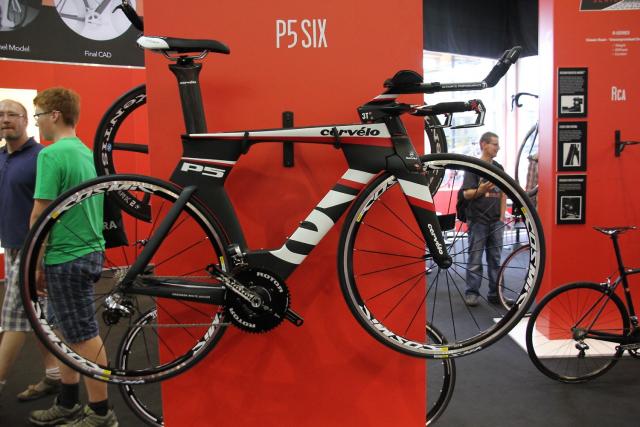
A decade or so ago, for example, Cervélo came out with a cutaway seat tube, the trailing edge following the leading edge of the rear wheel (this, above, is their up-to-date P5). These days, every single time trial bike on the market has something similar. Yes, there’s a degree of variation, but the principle is proven to work so everyone follows it to a greater or lesser extent. The same is happening in other areas of the bike…
Take the head tube area, for example. CFD (computational fluid dynamics) and wind tunnel testing have convinced most people that an integrated design is the most efficient way of managing airflow. In other words, rather than having a fork steerer that extends up beyond the height of the top tube with a stem added on top, manufacturers are now almost universally reducing the length of the head tube so that the stem sits flush with the top tube.
Manufacturers are doing a similar thing at the bottom of the head tube to bring the fork crown within the silhouette of the frame so as not to increase the size of the frontal area.
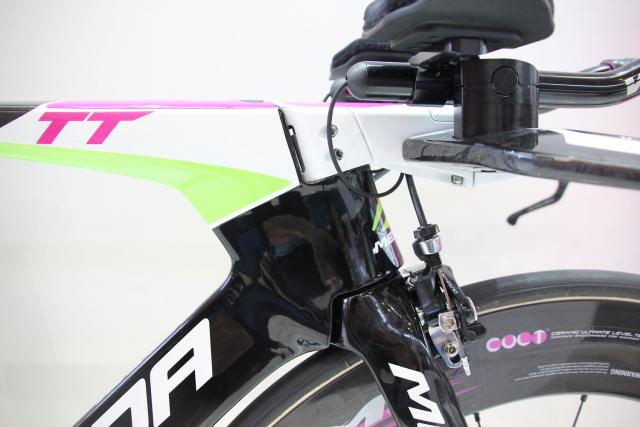
Here’s an example provided by the Merida Warp TT, for example. So, rather than having a head tube, a stem and a fork crown all presenting themselves to the wind, everything is integrated within the frame’s existing silhouette.
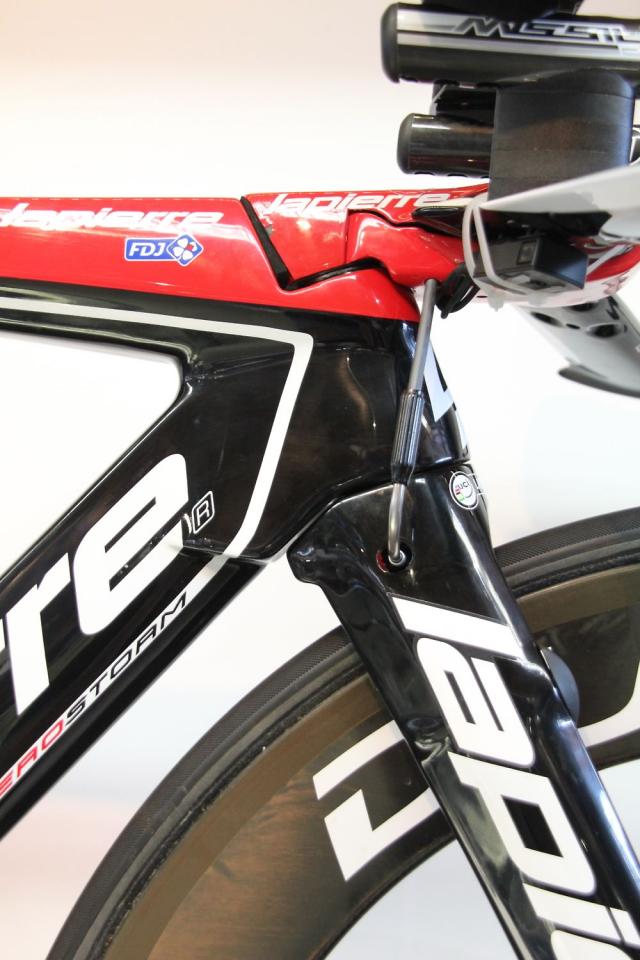
And here’s the Lapierre Aerostorm. It’s certainly a different design, but it has similar head tube elements with the integrated stem and the hidden fork crown.
The other basic head tube design that has been around for a few years now is with an external fork steerer. Running a fork steerer inside the frame means you need a head tube with a wide diameter. Run the steerer externally, with a bearing at the top and bottom of the head tube, and you can slim it down.
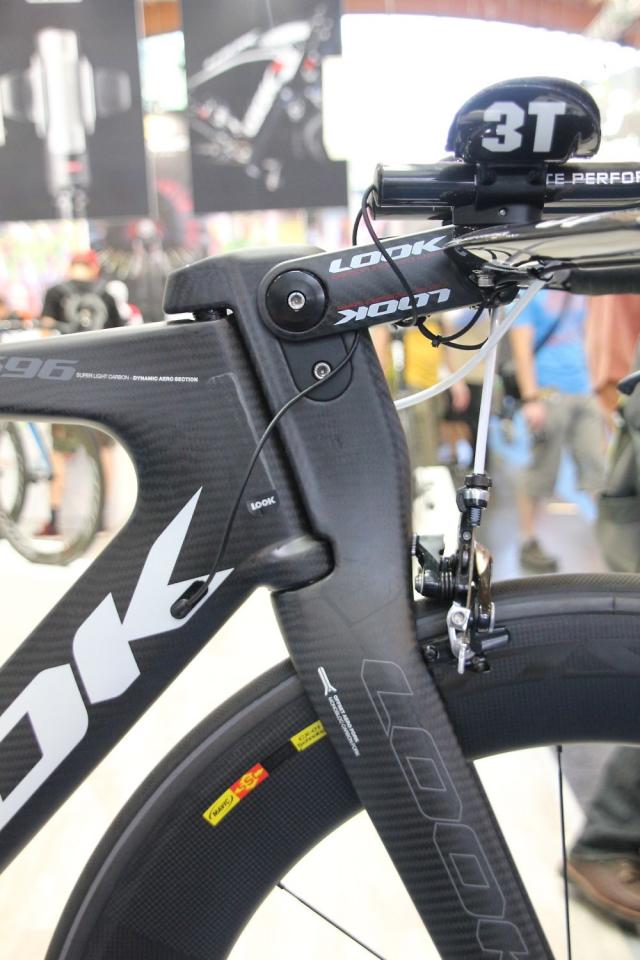
Here’s Look’s solution on their 596.

And here’s the Stevens Super Trofeo. They’re showboating it with an integrated stem too.
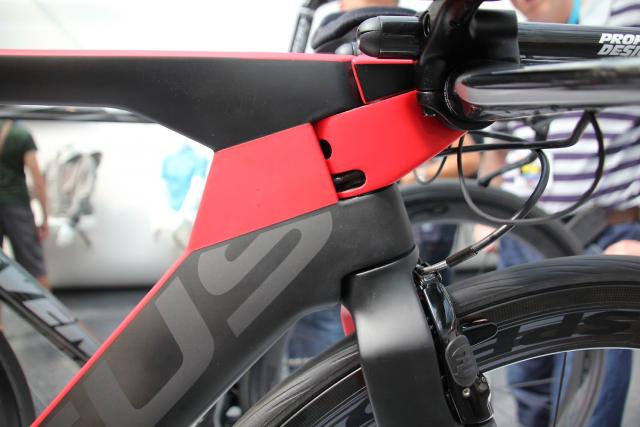
Interestingly, Focus are bucking the trends with the front end of their new Chrono Max. Check this out (above). So, they have a traditional-style fork steerer running through the head tube, then a stem, and then a bit more head tube. Is that how we're describing it? An interrupted head tube, maybe? Anyway, it's the first time we've seen this particular way of doing it. They certainly like it at Eurobike: the Chrono Max won a design award.
You’ll notice that the Merida (scroll up) and the Look (above just a little bit) have their front brake stuck out there in the traditional place at the front of the fork crown. When we went to see Merida earlier in the year, they told us that positioning the brake there meant a penalty in drag, but a tiny one. They were prepared to stick with that design for the convenience – simple wheel changes and so on.

Other brands, though, have been busy working on brake placement. Here’s the Ridley Dean with the V-type brake hidden behind the fork legs so that it’s just the brake shoes and brake blocks that increase the size of the frontal area.

And Cannondale do something similar with their Slice.

Storck position the brake within the fork on their Aero 2 and run the cable in via the fork crown. Check out the Lapierre (above) for a similar solution.

Trek weren't at Eurobike because they do their own Trek World shows in the summer where we saw the latest version of their Speed Concept TT bike.

The level of integration they've developed for their front brake is amazing.
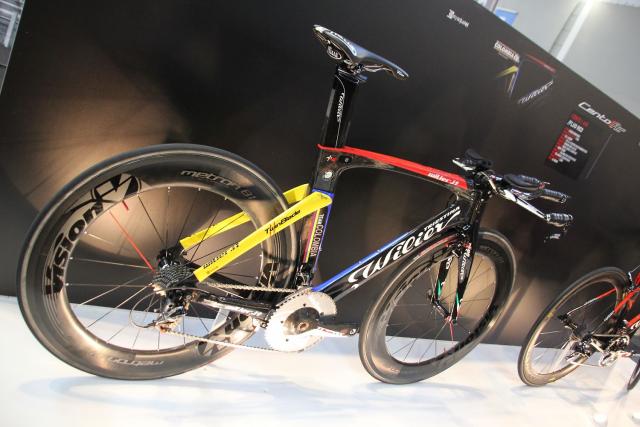
Positioning the rear brake behind the bottom bracket is a common approach. Not only is the brake sheltered there, it allows manufacturers to do without a brake bridge between the seatstays, as on this Wilier Twin Blade. That’s an aero benefit and also allows for a greater amount of compliance.

Felt have gone for a similar rear brake position on their new IA although this bike, unlike the others here, doesn’t comply with UCI regs. It’s designed as a triathlon/non-UCI time trial bike – hence those low slung seatstays and the super-deep frame elements.
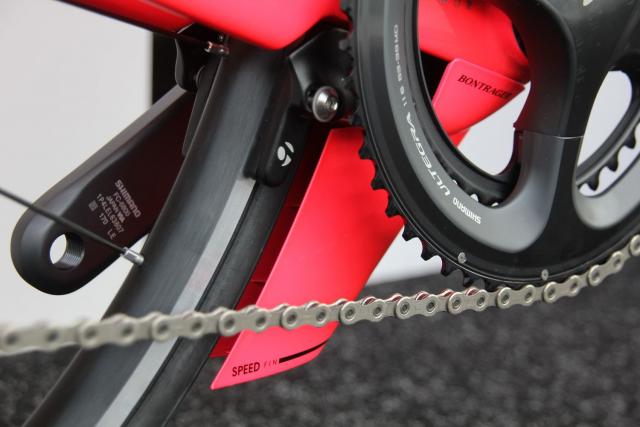
Trek have a Speed Fin that they fit to smooth the airflow over the rear brake on their Speed Concept TT bike. It's not UCI-legal, though, because it's a fairing; it's for use in triathlon.

Speaking of incompatibility with the UCI rules, this is the front end of the Cervélo P5 with a fairing running from the stem to the fork. This breaks the rules although it’s allowed in triathlon. Cervélo do make a UCI-compliant version, of course, without this arrangement.

That brings us neatly on to another frame element that’s doing the rounds now… the super deep seat tube and top tube junction. This is the P5’s (you can tell by the massive P5 written on the side!).
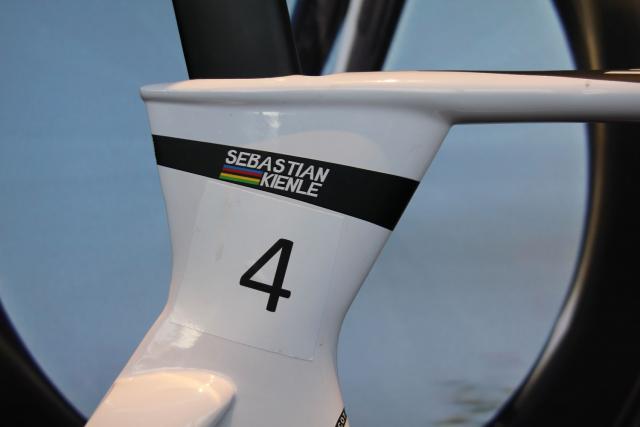
And here’s the same area from the Scott Plasma. It’s a broadly similar design.
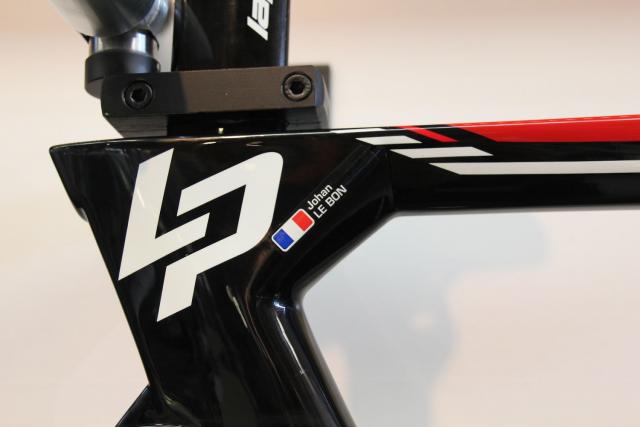
Lapierre’s Aerostorm is less extreme, but you can see that it’s coming from roughly the same place.
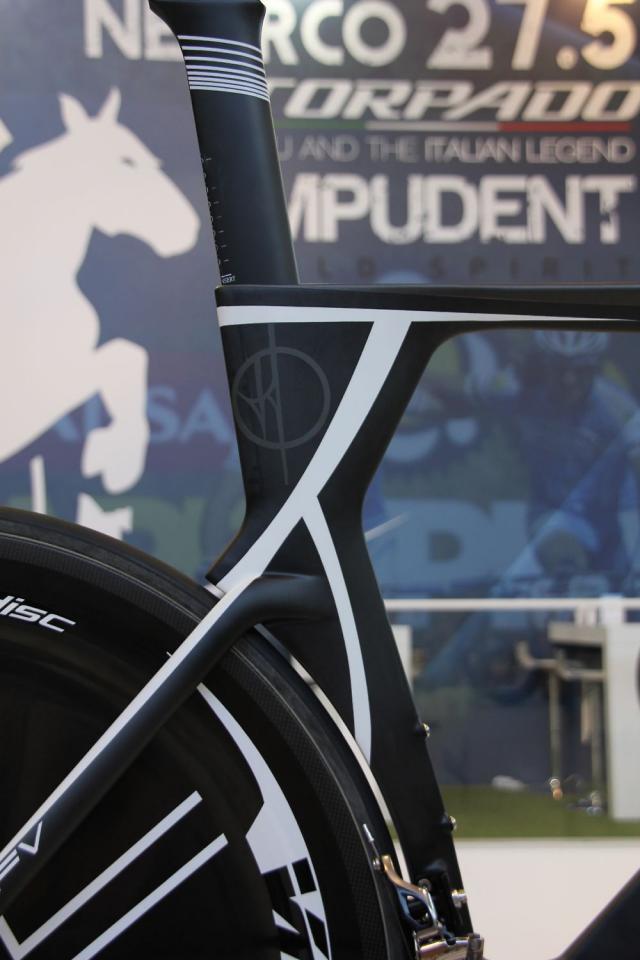
And the same goes for the Fondriest TVF.
One final feature that’s made ground over the past few years is the use of widely spaced seatstays, the idea being to get them as far as possible away from the rear wheel to help manage airflow over the back end of the bike.

You can easily see what we mean here with a rear view of the Ridley Dean. The chainstays kink out from the seat tube and give the rear wheel plenty of space before heading down towards the dropouts.

Here’s a side view of the Cannondale Slice doing a very similar thing.
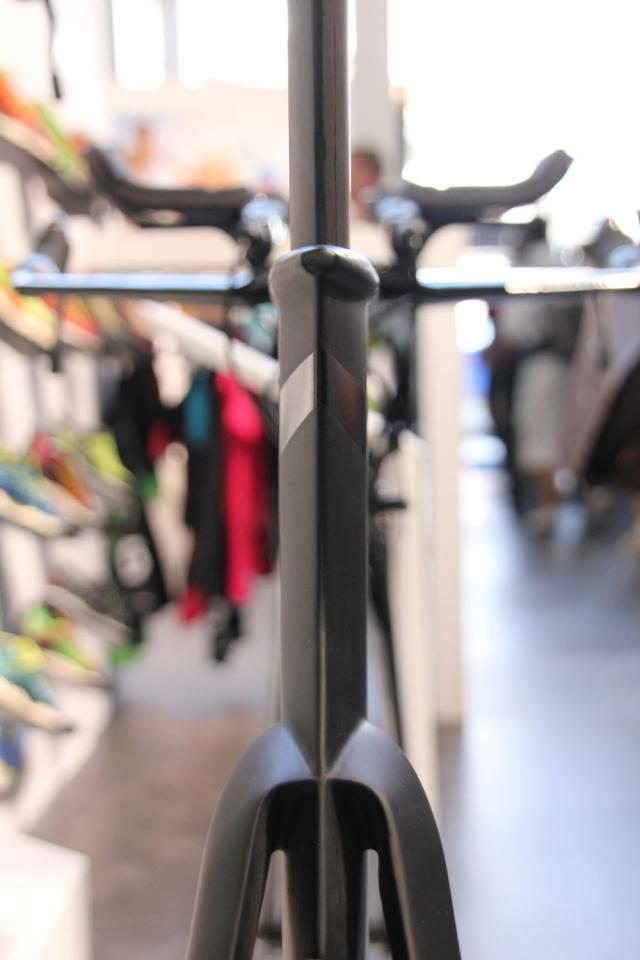
And the Scott Plasma. Cervélo, Merida, Wilier, Storck… They’re all at it!
Dig the new breed…
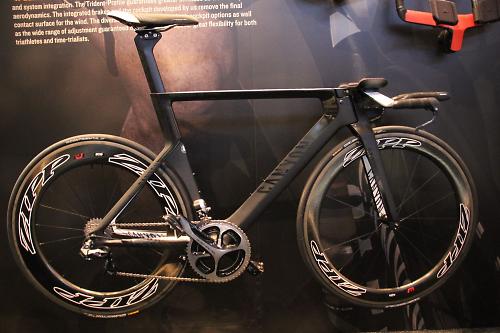
While time trial bike design is getting broadly more generic - there are, after all, only so many shapes you can throw given the parameters of wind tunnel testing, CFD software, the limits of manufacturing technology, the demands of the UCI technical regulations and the marketing department... oh, and let's not forget the laws of physics - there's still hours of innocent fun to be had spotting all that shared genetic code.

Scott Plasma head tube - careful now
The big (stylistic at least) divide amongst the current generation of aero bikes is over the length of their trailing edges. At one end of the spectrum are the Scott Plasma and the Cannondale Slice which have trailing edges sharp enough to give you a nasty paper cut.

Canyon, Focus, Merida and BMC, meanwhile, go for less depth. That's particularly noticeable at the seat tube where some of the vestigial trailing edges are almost chunky and where the seat tubes themselves are distinct rather than blending in to the top top in half an acre of carbon. In the middle are bikes like the Trek Speed Concept and the Stevens Super Trofeo which combine elements of both camps.
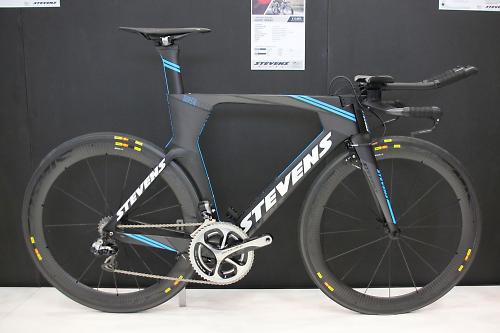

Our other general observation is that time trial bikes have got smaller - makes sense if you think about it. Not long ago they were imposing angular or bulbous things. The new generation from the major players are definitely more pared down affairs by comparison. The new fashion is small, thin, not too deep section, integrated/external/interrupted head tube/steerer/integrated brakes - and indeed anything else that can be integrated. Canyon, Focus, Merida, BMC and the new Pinarello Sibilo are prime examples. Of course, there are numerous differences in the details, but there's also a definite overall common look.

It may be just be that Canyon, BMC and the rest are in roughly the same place in their design cycle, they all use similar design software, or maybe even the same wind tunnel, but we can't help noticing that several of those brands have a strong Germanic connection.
Of course, it could also be that we have to factor into the mix the influence of the UCI technical regulations. The Focus Chrono Max may have won a Eurobike design award, but their bike was less radical than it would have been but for the UCI regulations.

That brings us on to what might be another emerging trend: sticking two fingers up to the UCI. For the last few years bike brands have routinely produced their time trial/triathlon bikes in both UCI-legal and triathlon versions. At first that meant simply reversing the seat post but over the years it has evolved into taking off bits deemed to make it illegally more aero: nose cones, integrated water bottles, bento boxes, and Trek's new aero fin. That means the road customer has to make do with an aerodynamically compromised version of the bike if they want to be UCI legal (though not every TT requires that).
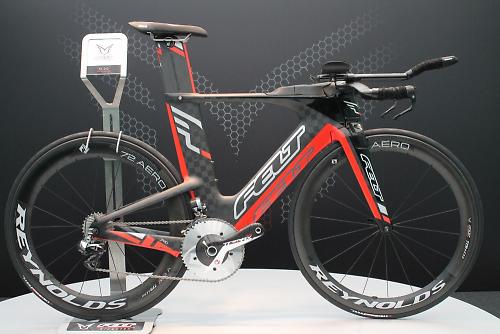
It will be interesting to see how the Focus Chrono Max does commercially compared with the the Felt IA. As we reported last week, Felt are the first of what might be called the big road brands to decide not to bother with the UCI tech regs when designing their new aero bike, instead building the fastest possible triathlon bike they could.
Another of the Eurobike award winners, Factor, have taken exactly the same route with their Vis-Vires aero road bike and then there are brands like Ceepo who have never bothered with what the UCI wanted in favour of simply building the most aero bike they could. We think we may well see more of this as the triathlon market grows and more manufacturers grow exasperated by the UCI's restrictions. It could also be intriguing to see how things play out on that score should Brian Cookson become the next UCI president, British Cycling (of which Cookson is President) being an organisation that has put a big emphasis on technical innovation over the past few years.
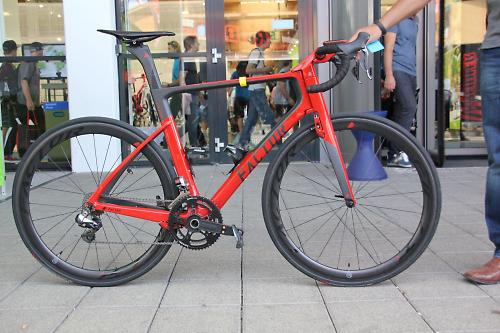
Factor Vis Vires
Looking in the crystal ball

Based on nothing more scientific than where they were placed on their respective stands at Eurobike - the further away from the heart of things, the less importance given by a manufacturer to any particular model - we'd say the Giant Trinity will be replaced for the next model year. Ditto the Speicalized Shiv, although it was an odd stand so maybe the rules don't apply there. You might want to take this logic with a health warning because the Giant Trinity still has something to offer going by the similarly upright approach Focus took with the seat post on the Chrono Max. In 2015, though, we would expect to see a lot of new aero bikes hit the shops as all those machines without internal cables and integrated front ends are replaced. That's quite a lot of bikes.
Latest Comments
- eburtthebike 6 min 32 sec ago
A sad case, and one with no winners. The driver can thank her lucky stars that the cyclist wasn't more seriously injured and that the court was...
- AidanR 1 hour 3 min ago
Bloody hell... How are you doing now?
- ktache 1 hour 11 min ago
And I liked endura too. Got a nice long sleeve mostly merino long sleeve a little while back, in orange.
- matthewn5 1 hour 39 min ago
No, the Ebay lights have been around for several years, this Lezyne light just appeared.
- chrisonabike 1 hour 55 min ago
They shouldn't worry - the second part of the "tariff" refrain is "they can make it in US and they'll do very well".
- Mr Blackbird 2 hours 27 min ago
"At the going down of the sun, it will get in our eyes and cause us to crash into things."
- Rendel Harris 2 hours 36 min ago
Been living in the area thirty years now and Brixton Cycles (and local riders wearing their famed Rastafarian colours jersey) has been an iconic...
- chrisonabike 4 hours 40 min ago
Does the "super-loud yellow" also help alert (non-deaf / non-earbud-wearing) pedestrians? Or will it just mean dogs bark at me?
- chrisonabike 7 hours 31 min ago
Indeed - but again these are perhaps questions we should keep asking. Even if the immediate answer is "well we are where we are" or "how on earth...






























































































































































Add new comment
8 comments
The Focus is certainly an interesting design, however, does it use 4 bearings or just the normal 2? The head-tube could have bending/stress issues if used on typical British TT courses!!
Funny looking things
so many to look at but there are a few stand out from the crowed bikes or sure. Felt looks like a beast and Canyon looks great. cervelo not so impressive.
The weird bit with the tri-specific bikes is that at the upper levels, the races are draft-legal and they're restricted to basically UCI Road Race (not TT) legal bikes (with the addtion of stubby mini clip on bars- can't poke out beyond the hoods). This leads to "club" Triathletes using fancier bikes than the pros.
Bike p0rn.....
Glad to see things moving On from the UCI dogma.
Any if those bikes would be the business. If only I had the money... And the time... And the roads... And...
I would be happy to be the proud owner of anyone of those nice TT bikes
<3 that Canyon....